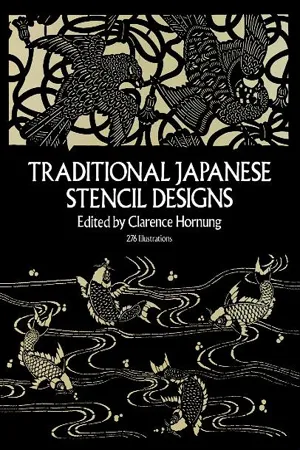![]()
INTRODUCTION
The vast panoramic scope of Japanese design, infinite as the heavens and boundless as the seas, is deeply rooted in the realm of nature. A reverence for all living things, an integral part of Buddhist and Shinto religions, engenders an awesome sense of beauty that embraces natural forces and animate creatures seldom glorified in the cultures of the West. Trees, mountains, rivers and celestial bodies are embodied as deified spirits, sanctified and worshipped with awe and affection. Sun, sky and sea . . . birds, beasts and butterflies . . . countless flora and fauna . . . these are the omnipresent elements of nature that provide and enrich the Japanese design vocabulary. For ages and ages these have served the artist symbolically and as embellishment and ornamentation, not only on kimonos and household goods but also on objects of sacred use in shrines. Woven textiles with delicate floral patterns and metalwork decorated with arabesques, blossoms and beasts appear as early as the Heian period (794–1185). Lacquers and items for personal use were decorated with naturalistic themes; the more personal the purpose, the more detailed and delicate the ornamentation.
In the gradual process of continuing development the Japanese craftsman learned to adapt and simplify design forms until they attained a degree of purity through progressive evolution. Each motif reached a stage of graphic perfection akin to shorthand symbols, which made their application to decorative usage ideal. For example, one can make a case study of the chrysanthemum (kiku), Nippon's imperial flower, and observe literally hundreds of variants so greatly conventionalized in construction and arrangement of petals as to produce endless diversity of decorative interpretations. This extraordinary talent of the Japanese to reduce representational forms to ideographic motifs makes patterns inviting, intriguing and always optically exciting.
To attempt an inventory of these sources of inspiration would be as hopeless as trying to count the heavenly bodies on a clear, starry night. Yet some simple classification would be helpful in categorizing the boundless domain of the world of nature. Above all, the heavens have held an endless fascination for the Japanese. Cloud patterns (kumo) assume many different forms, often cumulus, wavy or nebulous, changing into mist (kasumi). Lightning (inazuma), with its martial connotations and the thunderbolt, lends itself to stylization, suggesting fecundity and the basic forces of life. Most familiar in Japanese prints and paintings, and carried over into graphic representations, is the moon (tsuki) in its various phases, perennially suggestive of poetic imagery. It is often combined with other motifs that can be traced back to Chinese origins as a manifestation of yin, the passive or female force in the universe. Just as the early Japanese of the Nara and Heian periods borrowed freely from Chinese astrology, so the stars (hoshi) have figured prominently in traditional pattern decoration of the Japanese. The star as a symmetrical entity or used in groups of three, five or seven was popularized by the shogun and warrior classes for centuries past. But the capstone of all heavenly bodies remains the sun (hi), which appears as the big red disc or “rising sun” that had its origins over a thousand years ago. It was in 1854, coinciding with Admiral Perry's epochmaking treaty, that it was adopted as a national emblem and shortly thereafter as the imperial emblem on the nation's flag. The firm basis for the sun's universal acceptance lies in the legends that trace the origins of the imperial line to the Sun Goddess. The completeness of the circular disc, without beginning or end in its linear outline, accounts for its versatile use as a design motif and its persistent popularity in all forms of decorat...
